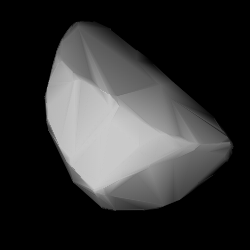Astronomy:1652 Hergé
 Shape model of Hergé from its lightcurve | |
| Discovery[1] | |
|---|---|
| Discovered by | S. Arend |
| Discovery site | Uccle Obs. |
| Discovery date | 9 August 1953 |
| Designations | |
| (1652) Hergé | |
| Named after | Georges Remi (Hergé) cartoonist[2] |
| 1953 PA · 1933 UE1 1939 HG | |
| Minor planet category | main-belt · Flora[3] |
| Orbital characteristics[1] | |
| Epoch 4 September 2017 (JD 2458000.5) | |
| Uncertainty parameter 0 | |
| Observation arc | 83.41 yr (30,464 days) |
| |{{{apsis}}}|helion}} | 2.5883 AU |
| |{{{apsis}}}|helion}} | 1.9139 AU |
| 2.2511 AU | |
| Eccentricity | 0.1498 |
| Orbital period | 3.38 yr (1,234 days) |
| Mean anomaly | 34.960° |
| Inclination | 3.1989° |
| Longitude of ascending node | 251.72° |
| 13.107° | |
| Physical characteristics | |
| Dimensions | 8.689±0.081 km[4] 8.954±0.083 km[5] 9.41 km (calculated)[3] |
| Rotation period | 16.36±0.02 h[lower-alpha 1][lower-alpha 2] |
| Geometric albedo | 0.1160±0.0215[5] 0.137±0.028[6] 0.24 (assumed)[3] 0.308±0.060[4] |
| S[3][7] | |
| Absolute magnitude (H) | 12.20[4] · 12.3[1][3] · 12.54±0.19[7] · 13.2[5] |
1652 Hergé, provisional designation 1953 PA, is a stony Florian asteroid from the inner regions of the asteroid belt, approximately 9 kilometers in diameter. It was discovered on 9 August 1953, by Belgian astronomer Sylvain Arend at the Royal Observatory of Belgium in Uccle, Belgium.[8] It was later named after Belgian cartoonist Hergé.[2]
Orbit and classification
Hergé is a member of the Flora family, one of the largest families of stony asteroids. It orbits the Sun in the inner main-belt at a distance of 1.9–2.6 AU once every 3 years and 5 months (1,234 days). Its orbit has an eccentricity of 0.15 and an inclination of 3° with respect to the ecliptic.[1] It was first identified as 1933 UE1 at Heidelberg Observatory in 1933, extending the body's observation arc by 20 years prior to its official discovery observation.[8]
Physical characteristics
Hergé has been characterized as a common S-type asteroid by Pan-STARRS photometric survey.[7]
Rotation period
Astronomer Petr Pravec obtained a rotational lightcurve of Hergé from photometric observations taken at Ondřejov Observatory in September 2014.[lower-alpha 2] It gave a rotation period of 16.36 hours with a brightness amplitude of 0.42 magnitude ({{{1}}}).[lower-alpha 1]
Diameter and albedo
According to the survey carried out by NASA's Wide-field Infrared Survey Explorer with its subsequent NEOWISE mission, Hergé measures between 8.68 and 8.95 kilometers in diameter, and its surface has an albedo between 0.116 and 0.308.[4][5][6] The Collaborative Asteroid Lightcurve Link assumes an albedo of 0.24 – derived from 8 Flora, the largest member and namesake of this orbital family – and calculates a diameter of 9.41 kilometers with an absolute magnitude of 12.54.[3]
Naming
This minor planet was named in honor of Belgian cartoonist Georges Remi, better known under his pseudonym Hergé. He is considered to be the father of the fictional Adventures of Tintin, one of the most popular European comics of the 20th century, and creator of its hero, Tintin, in 1929.[2] The asteroid 1683 Castafiore was also named after the comic-strip character Bianca Castafiore from the series. The approved naming citation was published by the Minor Planet Center on 8 April 1982 (M.P.C. 6831).[9]
Notes
- ↑ 1.0 1.1 Pravec (2014) web (2014-09-18): rotation period of 16.36±0.02, 0.42 mag, (quality code of 3-). Summary figures for (1652) Herge at Asteroid Lightcurve Database and Pravec, P.; Wolf, M.; Sarounova, L. (2014)
- ↑ 2.0 2.1 lightcurve plot of (1652) Hergé. Lightcurve analysis by Petr Pravec
References
- ↑ 1.0 1.1 1.2 1.3 "JPL Small-Body Database Browser: 1652 Herge (1953 PA)". Jet Propulsion Laboratory. https://ssd.jpl.nasa.gov/sbdb.cgi?sstr=2001652. Retrieved 30 June 2017.
- ↑ 2.0 2.1 2.2 Schmadel, Lutz D. (2007). "(1652) Hergé". Dictionary of Minor Planet Names – (1652) Hergé. Springer Berlin Heidelberg. p. 131. doi:10.1007/978-3-540-29925-7_1653. ISBN 978-3-540-00238-3.
- ↑ 3.0 3.1 3.2 3.3 3.4 3.5 "LCDB Data for (1652) Hergé". Asteroid Lightcurve Database (LCDB). http://www.minorplanet.info/PHP/generateOneAsteroidInfo.php?AstInfo=1652%7CHergé. Retrieved 25 December 2016.
- ↑ 4.0 4.1 4.2 4.3 Masiero, Joseph R.; Mainzer, A. K.; Grav, T.; Bauer, J. M.; Cutri, R. M.; Nugent, C. et al. (November 2012). "Preliminary Analysis of WISE/NEOWISE 3-Band Cryogenic and Post-cryogenic Observations of Main Belt Asteroids". The Astrophysical Journal Letters 759 (1): 5. doi:10.1088/2041-8205/759/1/L8. Bibcode: 2012ApJ...759L...8M. http://adsabs.harvard.edu/cgi-bin/bib_query?bibcode=2012ApJ...759L...8M. Retrieved 25 December 2016.
- ↑ 5.0 5.1 5.2 5.3 Mainzer, A.; Grav, T.; Masiero, J.; Hand, E.; Bauer, J.; Tholen, D. et al. (November 2011). "NEOWISE Studies of Spectrophotometrically Classified Asteroids: Preliminary Results". The Astrophysical Journal 741 (2): 25. doi:10.1088/0004-637X/741/2/90. Bibcode: 2011ApJ...741...90M.
- ↑ 6.0 6.1 Masiero, Joseph R.; Grav, T.; Mainzer, A. K.; Nugent, C. R.; Bauer, J. M.; Stevenson, R. et al. (August 2014). "Main-belt Asteroids with WISE/NEOWISE: Near-infrared Albedos". The Astrophysical Journal 791 (2): 11. doi:10.1088/0004-637X/791/2/121. Bibcode: 2014ApJ...791..121M. http://adsabs.harvard.edu/cgi-bin/bib_query?bibcode=2014ApJ...791..121M. Retrieved 25 December 2016.
- ↑ 7.0 7.1 7.2 Veres, Peter; Jedicke, Robert; Fitzsimmons, Alan; Denneau, Larry; Granvik, Mikael; Bolin, Bryce et al. (November 2015). "Absolute magnitudes and slope parameters for 250,000 asteroids observed by Pan-STARRS PS1 - Preliminary results". Icarus 261: 34–47. doi:10.1016/j.icarus.2015.08.007. Bibcode: 2015Icar..261...34V. http://adsabs.harvard.edu/cgi-bin/bib_query?bibcode=2015Icar..261...34V. Retrieved 25 December 2016.
- ↑ 8.0 8.1 "1652 Herge (1953 PA)". Minor Planet Center. https://www.minorplanetcenter.net/db_search/show_object?object_id=1652. Retrieved 25 December 2016.
- ↑ "MPC/MPO/MPS Archive". Minor Planet Center. https://www.minorplanetcenter.net/iau/ECS/MPCArchive/MPCArchive_TBL.html. Retrieved 25 December 2016.
External links
- Asteroid Lightcurve Database (LCDB), query form (info )
- Dictionary of Minor Planet Names, Google books
- Asteroids and comets rotation curves, CdR – Observatoire de Genève, Raoul Behrend
- Discovery Circumstances: Numbered Minor Planets (1)-(5000) – Minor Planet Center
- 1652 Hergé at AstDyS-2, Asteroids—Dynamic Site
- 1652 Hergé at the JPL Small-Body Database
 |

